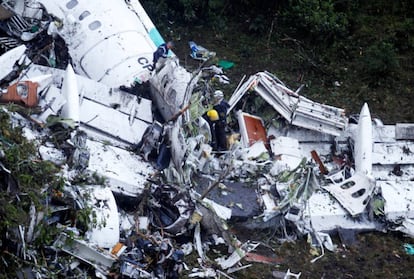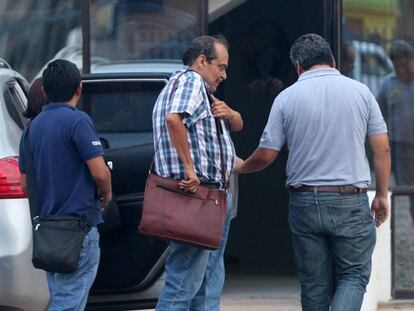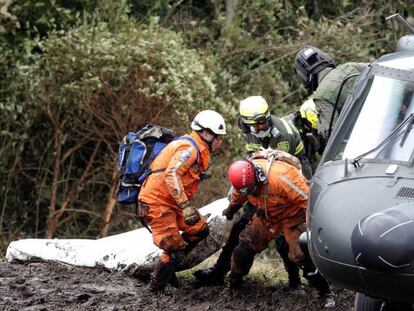Report confirms human error caused Chapecoense plane crash
Colombia’s Civil Aviation Authority publishes preliminary investigation into accident that killed 71 people
The LaMia plane that crashed while carrying Brazil’s Chapecoense soccer team failed due to “human error,” Colombia’s Civil Aviation Authority said in its preliminary report on the accident that led to 71 deaths on November 29. The investigation has concluded that the aircraft left Santa Cruz, Bolivia with just enough fuel to make the journey and no reserves in case of an emergency. The plane was left empty while waiting to land and crashed near Medellín airport, the report says.

Transcriptions of the aircraft’s black box recordings by its London manufacturer and audio recordings from the pilot’s cabin and at Colombian air traffic control centers confirmed that the pilot and co-pilot knew of the fuel shortage. “Both talked about the possibility of refueling in Leticia [a city in southern Colombia that shares borders with Brazil and Peru] or Bogota,” said Freddy Bonilla, secretary of Colombia’s Aviation Security Agency. Yet, the crew did not stop in either city and, once the plane entered Colombian airspace, they had to fly in a headwind. “That requires more power, therefore greater fuel consumption.”
The errors that led to the crash began at the airline’s office in Bolivia. The flight plan failed to account for 1.5 hours of fuel reserves and flight time required by air traffic regulations and only listed one alternative airport, El Dorado in Bogota, when they needed at least two. The flight dispatcher who approved the journey did not sign the flight plan. The plane was also carrying 500 kilos more than its maximum permitted cargo weight.
The flight plan failed to account for 1.5 hours of fuel reserves and only listed one alternative airport
The report said that once the plane reached Bogota, the pilot warned that, given the amount of gasoline, he would need to make a “vertical landing.” “This kind of aircraft has a sound-and-light alarm system that goes off when fuel is low,” Bonilla explained. “According to the manual, it gives [the pilot] an average of 20 minutes of flight time once it is activated.” Yet, the pilot failed to warn air traffic controllers in Medellín. Thirteen minutes before the accident, he entered a holding pattern as he waited for authorization to land. Eight minutes before the crash, the co-pilot called for a priority landing. “We must remember that priority does not mean emergency,” Bonilla explained. Controllers told the pilot the most direct route available but, without warning, the plane began to descend faster than it should have.
The crew only warned of its fuel shortage six minutes before the accident. “I am asking you for a final destination right now,” a voice says on the recording. Medellín changed the routes of other aircrafts to accommodate landing. “We now know that one of the four engines had shut down but he crew did not report it,” Bonilla continued. Twelve seconds later, another engine failed. The control center asked whether the pilots required additional support once they landed but they said they would confirm later.
“Total shutdown, no electricity, no fuel,” one voice says on the recording two minutes before impact. “The aircraft descends rapidly, below the minimum altitude that radars measure and the signal is lost.”
The crew only warned of its fuel shortage six minutes before the accident
Colombia is legally responsible for the investigation because the accident took place on its territory but it has collaborated with Bolivian, Brazilian and British experts. London transcribed the black boxes, the basis of these preliminary conclusions. “Our only objective is to avoid new accidents,” said Alfredo Bocanegra, director of Colombia’s Civil Aviation Authority. If the investigation leads to legal charges, the case will then be left up to the courts.
The final report will be published in April.
Tu suscripción se está usando en otro dispositivo
¿Quieres añadir otro usuario a tu suscripción?
Si continúas leyendo en este dispositivo, no se podrá leer en el otro.
FlechaTu suscripción se está usando en otro dispositivo y solo puedes acceder a EL PAÍS desde un dispositivo a la vez.
Si quieres compartir tu cuenta, cambia tu suscripción a la modalidad Premium, así podrás añadir otro usuario. Cada uno accederá con su propia cuenta de email, lo que os permitirá personalizar vuestra experiencia en EL PAÍS.
¿Tienes una suscripción de empresa? Accede aquí para contratar más cuentas.
En el caso de no saber quién está usando tu cuenta, te recomendamos cambiar tu contraseña aquí.
Si decides continuar compartiendo tu cuenta, este mensaje se mostrará en tu dispositivo y en el de la otra persona que está usando tu cuenta de forma indefinida, afectando a tu experiencia de lectura. Puedes consultar aquí los términos y condiciones de la suscripción digital.
More information
Últimas noticias
The complicated life of Francesca Albanese: A rising figure in Italy but barred from every bank by Trump’s sanctions
Half of Scotland is in the hands of 420 property owners
Pinochet’s victims grapple with José Antonio Kast’s rise in Chile
Reinhard Genzel, Nobel laureate in physics: ‘One-minute videos will never give you the truth’
Most viewed
- Pablo Escobar’s hippos: A serious environmental problem, 40 years on
- Why we lost the habit of sleeping in two segments and how that changed our sense of time
- Charles Dubouloz, mountaineering star, retires at 36 with a farewell tour inspired by Walter Bonatti
- Trump’s obsession with putting his name on everything is unprecedented in the United States
- The Florida Keys tourist paradise is besieged by immigration agents: ‘We’ve never seen anything like this’











































